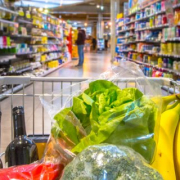Cold Storage, Hot Assets: Online Food Shopping, Pharma And Vaccine Bring CRE’s Strongest Property Class To Forefront
Long before the novel coronavirus pandemic sent Americans racing for their smartphones to order groceries, industrial real estate observers were keeping a close eye on the availability of temperature-controlled warehouses.
Covid-19 vaccines that require very specific temperatures — Moderna Inc.’s vaccine requires temperatures of minus-20 degrees Celsius and Pfizer Inc.’s candidate requires storage at minus-70 degrees Celsius — have put cold-storage warehouses in the spotlight in recent weeks.
But the sector has seen little vacancy for years, and industrial real estate experts don’t expect that to change as consumers shift more of their food shopping online, even after the pandemic is in the past.
Historically, the national vacancy rate of cold-storage warehouses has hovered below 10%, according to JLL, and much of that inventory is aging and rapidly approaching functional obsolescence. The average cold-storage warehouse in the U.S. is 42 years old, according to JLL.
“If we have a client who wants to know all the available temperature-controlled storage in the U.S. … on any given day, this isn’t something that takes up 10 pages,” said Tray Anderson, Cushman & Wakefield Inc.’s logistics and industrial lead for the Americas. “It’s more like two or three.”
The lack of available space is a function of economics: Temperature-controlled warehouses cost nearly twice as much to build as their dry-storage counterparts, according to JLL, which forecasts that those construction costs will only rise as demand intensifies. A temperature-controlled warehouse can cost $130 to $180 a square foot, whereas construction costs for a conventional warehouse range from $70to $90 a square foot.
“That pricing makes speculative construction — breaking ground without a signed tenant in place — difficult but not impossible,” said Anderson, who is based in North Carolina.
But the uptick in demand from food companies and retailers — coupled with the variable of a massive vaccine-distribution effort — is enough to embolden some developers to try their hand at speculative construction. Already, 95% of U.S. food goes through a third-party distribution center before it reaches consumers, according to CBRE Group Inc. And as early as May 2019, CBRE predicted that the country needed an additional 75 million to 100 million square feet of cold-storage space to meet demand for direct-to-consumer food orders — and that was before the pandemic threw online ordering of everything from furniture to food into overdrive.
“JLL is tracking more than 20 speculative cold-storage developments,” said Dustin Volz, a managing director on JLL’s capital markets team who specializes in such properties.
Cold-storage properties tend to be specific to individual users, but Anderson said projects could at least begin construction by pouring a floor that can handle a specific temperature.
“Speculative cold storage is still challenging, but a few select developers are figuring it out,” said Volz, who is based in Dallas.
Vaccines for the novel coronavirus aren’t expected to drive much additional supply for cold storage because the goal will be to administer the vaccines quickly. What that might do for short-term demand for space is another matter.
“The growth we’re talking about isn’t really vaccine-related; it’s food,” Anderson said. “Especially at minus-20 degrees … Minus 20 is much more common with pharma and food. You can find space that can do minus 20. You’re not going to find any vacant space at minus 80.”
Volz agreed that food is driving the majority of the demand — and that the pandemic highlighted weaknesses in the U.S. food supply chain, such as its reliance on international vendors and inability to handle sudden upticks in demand.
“The need for excess warehouse space is therefore a result of keeping additional inventory to handle any surges in food demand,” Volz said, “and maintaining a domestic supply chain with the unrestrained geographical access for the population with supplemental food imports to complement the new infrastructure.”
Source: SFBJ











